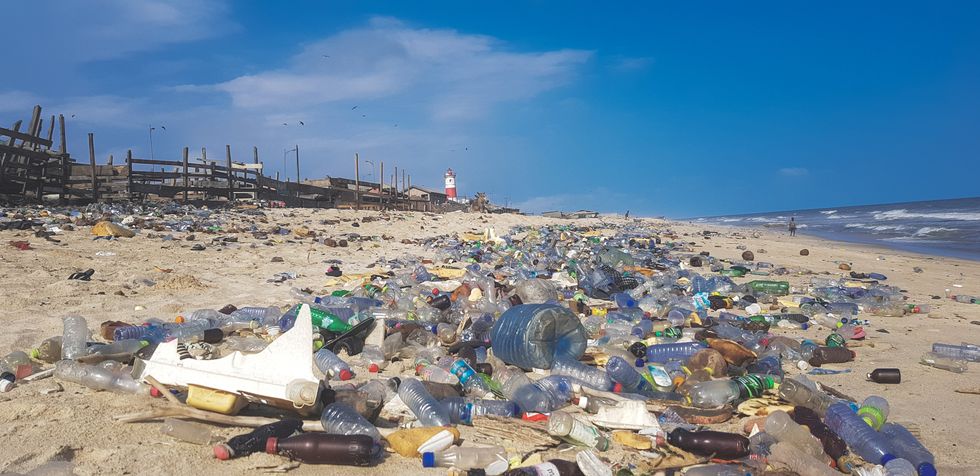
Plastic pollution, explained
How plastics damage our lives and the environment—and why recycling is not the answer.
Plastics: we can't live without them, or so it seems.
While using plastics in some cases may be unavoidable, we can take steps to reduce our constant consumption and discarding of the chemical-laced material.
The U.S. produces 234 pounds of plastic waste per person per year, and hardly any of it is recycled.
Here's a comprehensive introduction to plastic waste and plastic pollution, how we got here, and what we can do about it.
The problem

An excavator pushes through a landfill. About 79% of plastic is ending up in landfills or as litter in our environment. (Credit: Tom Fisk/Pexels)
Plastics are an untamed and unmanaged beast:
- More than 1 million plastic bags are used every minute, with an average "working life" of only 15 minutes
- 500 billion plastic bags are used annually—and that's just plastic bags.
- Of all plastics the world has produced, only 9% of the nine billion tons has been recycled—most ends up in landfills, dumps, or in the environment.
- The ocean is expected to contain 1 ton of plastic for every 3 tons of fish by 2025 and, by 2050, more plastics than fish (by weight).
- Studies suggest that the total economic damage to the world's marine ecosystem caused by plastic amounts to at least $13 billion every year.
- If current consumption habits continue, we're on pace to have discarded 12 billion tons of plastic waste into landfills and our environment by 2050.
How'd we get here?
Two marketing strategies employed by the plastics industry have successfully propelled plastic to regular household use:
- Promoting throwaway culture
- Creating eco-campaigns that shift blame to the individual.
These strategies, along with the lack of legislation preventing mass consumption, have caused single-use plastics to flourish.
Throwaway culture

Food in disposable plastic packaging is a common sight in grocery stores.
Throwaway culture is a modern phenomenon that was slowly impressed upon the consumer after the Great Depression and war-era years of frugality. Through advertisement, the plastics industry had to convince the public that single-use plastics were possible, acceptable, and even necessary.
Today it's hard to imagine a world without single-use plastics: our "to-go," "hustle," and "convenience" cultures have adopted and even celebrated the ease of disposables.
- In 2013, the plastics industry put 78 million tons of plastic packaging on the market, with a total value of $260 billion.
- 95% of that plastic packaging's material value, or $80 billion to $120 billion annually, is lost to the economy after a short first use—but the ease and low cost of churning out more disposables prevents the effort to maintain that value after it's sold.
In detail:This captivating article by Rebecca Altman highlights the lobbying efforts that led to the eternal existence of the plastic bag. "If the plastics industry wants to drive sales ... it must teach customers how to waste."
Eco-campaigns

The recycle symbol—a sign of environmental activism—also encourages consumption. (Credit: ready made/pexels)
The recycling logo—one of the most recognizable images of the environmental movement—was created in a contest held by a plastics company.
It's an icon that persuades consumers we can continue to consume products and materials, because the cycle will create an ecological balance between production and consumption that mitigates the environmental impact.
Failure to recycle is placed on the individual consumer, not on the manufacturer—even though many common plastics can't be recycled, and the fact that 91% of plastic not being recycled suggests a systematic failure.
- Stat: For all its campaigns, the United States recycles less than 10% of its plastics.
Campaigns such as "Keep America Beautiful" were also funded by companies that produce plastic waste, such as Coca-Cola and Dixie Cup.
The message suggests individual responsibility to keep litter out of our environment, and invokes individual guilt and shame for the pollution that is there.
Again, it effectively shifts blame from corporations mass-producing pollutants, the root cause of the issue.
Lack of legislation

Plastic shopping bags are one of the greatest contributors to plastic waste. (Credit: Peteruetz/Wikipedia)
Another reason plastic waste and pollution has amassed so quickly is the lack of legislation regulating plastics. As of May 2020, there are currently no federal laws restricting single-use plastics, the single highest contributor to plastic waste.
Congress could work to shape federal policy by modeling legislation after existing local and state laws passed to tackle the plastics problem.
- For example, in 2015, Congress passed a federal act banning plastic microbeads in health and beauty products after several states did the same.
Today, however, the plastics problem remains unregulated and continuously building. The recent coronavirus pandemic has resulted in a ban on reusable bags in grocery and retail stores, prompting greater usage of single-use plastic bags that activists have worked so hard to discourage.
In detail: Focusing on BPA, this article from our founder Pete Myers discusses why chemical regulation, thought to stifle innovation, is key to reversing today's epidemic of chronic diseases.
About plastics

Plastic was first invented in 1862 as a substitute for ivory.
During World War II, plastics gained popularity as military resources. After the war ended, the plastics industry began marketing to consumers: in the 1950s, polyester and polypropylene were introduced into consumer products, and plastics took off from there.
In detail: This article from the Science History Institute covers the rise of the plastic empire, from origins to looking into the future.
A variety of chemical building blocks are used to construct plastics; the resulting wide range of unique properties is what makes plastic so versatile.
However, its benefits were quickly discovered and mass-produced without concern for the detriments:
- Plastic doesn't biodegrade, instead, it breaks into smaller and smaller fragments of plastic—known as microplastics—that are much more difficult to remove from the ocean and appear in our drinking water, food, and air.
- The very same chemicals that make plastic so useful can also release toxics into your food, body, and overall lifestyle.
In detail: Our year-long investigation into the common plastic additive BPA reveals dangerous neglect by the federal government to protect our health.
Impact on your health

Many chemicals found in plastics can have adverse effects on human health, including increased risk of infertility.
Exposure to microplastics, as well as the chemicals added to plastics during processing, harm our health.
- Stat: Microplastics have been found in 90% of bottled water and 83% of tap water.
Many chemicals used in plastics are known endocrine disruptors, causing reproductive issues such as infertility, hormonal imbalances, and greater risk of cancer.
- For example, the phthalate DEHP, added to plastic goods to make them more flexible (garden hoses, shower curtains, medical equipment, etc) is a probable human carcinogen.
In detail:This article by Pete Myers demonstrates the issues (read: toxics) that can arise with recycling plastics into food packaging.
Impact on the environment

Plastic pollution that has washed up on the shores of Ghana. (Credit: Wikimedia Commons)
Plastic causes an overabundance of problems when discarded into our environment.
- Plastic bags block waterways and clog sewers, providing breeding grounds for insects like mosquitoes that in turn proliferate the risk of diseases such as malaria.
- In poorer countries, plastic waste is burned as heat for cooking, exposing people to toxic emissions and contributing to poor air quality.
- Floating plastic debris serves as a vehicle for alien species to hitchhike to unfamiliar parts of the world, becoming invasive species and threatening biodiversity.
Plastics are also one of the main end products of fracking—a practice linked to water and air contamination. Fossil fuels are used to make plastic, so as the demand for plastics increases, it supports the natural gas and oil industry.
In detail:This piece published for World Environment Day visually demonstrates just how much plastic ends up in our waterways, and this story from Jessica Knoblauch emphasizes the environmental toll of plastics.
Impact on wildlife

Seabirds using plastic waste to build nests. It's estimated that 99% of seabirds will have ingested plastic waste by 2050. (Credit: Wikimedia Commons)
Many marine species, such as turtles and dolphins, mistake plastic fragments for food. Ingesting plastic is often fatal to animals—too much plastic blocks their digestive tracts, causing them to starve.
- Stat: Plastic fragments have been found in 86% of all sea turtle species, 44% of all seabird species, and 43% of all marine mammal species.
Styrofoam products, containing possible carcinogens such as benzene and styrene, are highly toxic when ingested and can damage animals' lungs, nervous systems, and reproductive organs.
Chemicals ingested by these animals can make their way up the food chain onto our dinner plates.
Where we’re at

Global plastic bag bans, July 2019. Source: UNEP
The tide of plastic waste has yet to be stemmed. However, attention given to the issue has dramatically increased in recent years. Countries across the world have taken steps to ban single-use plastics and ramp up access to recycling.
In detail:This article by Stephen Buranyi for The Guardian looks at "the worldwide revolt against plastic" - and whether "our rage" will be enough to make a difference.
We're getting there. In Sweden, only 4% of household waste ends up in landfills—the rest is either recycled or used as fuel in waste-to-power energy plants.
The success in Sweden has led to waste-to-energy initiatives in four other European countries. Kenya's strict plastic bag ban has led to so much success that other east African nations are considering following suit.
The EU approved a single-use plastic ban, and countries such as Canada and Peru have plans in place as well. Eight U.S. stateshave plastic bag bans, with additional major cities following suit.
Progress is being made. However, change at the corporate level is of the utmost importance for large-scale effects.
In detail:Look into the future of plastic and plastic waste with our founder and Chief Scientist, Pete Myers.
Take action on plastic pollution
If this matters to you, say something. Contact your local government, pressure your representatives, find others in your community that also care.
To be clear, change doesn't have to start with federal legislation: it can begin in your home and in your consumption habits.
- Forgo plastic in favor of glass and metal alternatives, from water bottles to food storage containers.
- Use a reusable water bottle and avoid sending 167 plastic bottles per year to the landfill.
- Using plastic wrap? Switch to tinfoil or beeswax wraps.
- Plastic sponges are inefficient and get destroyed easily. Instead, use a bristle brush or steel wool.
- There are so many other plastic alternatives out there—growing consumer demand is changing the market. Do your research and make the change for your health, your wallet, and the environment.
Interested in learning more? Sign up for our free Plastic Pollution weekly newsletter, sponsored by Plastic Pollution Coalition, for the most up-to-date information about plastics.
Further reading
From making it to managing it, plastic is a major contributor to climate change
Freshwater is getting neglected when it comes to plastic pollution research
Financial fallout from coronavirus could devastate the fracking and plastics industries
Banner photo credit: Marco Verch/flickr





















